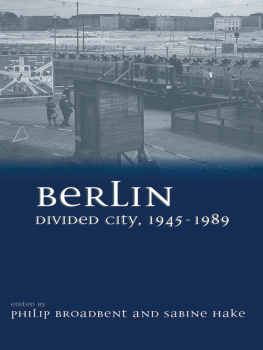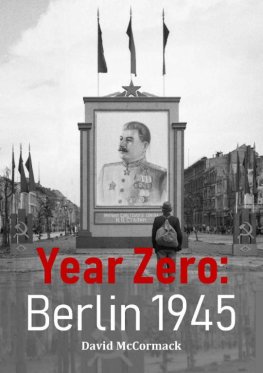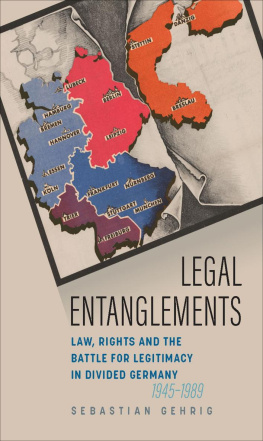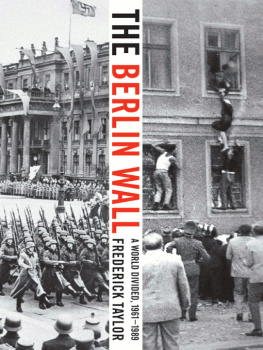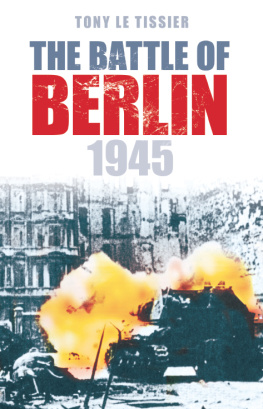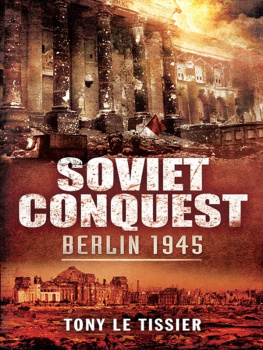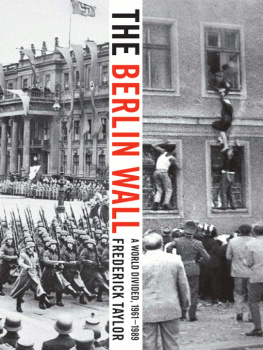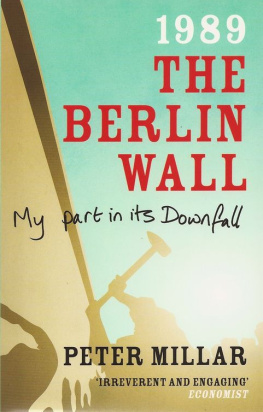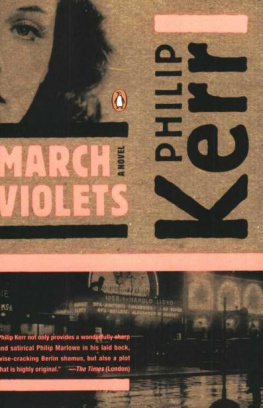BERLIN DIVIDED CITY, 19451989
Culture and Society in Germany
General Editors: Eva Kolinsky and David Horrocks
Volume 1: Turkish Culture and German Society Today
Edited by David Horrocks and Eva Kolinsky
Volume 2: Sinti and Roma: Gypsies in German-Speaking Society and Literature
Edited by Susan Tebbutt
Volume 3: Voices in Times of Change: The Role of Writers, Opposition Movements and the Churches in the Transformation of East Germany
Edited by David Rock
Volume 4: Coming Home to Germany?: The Integration of Ethnic Germans from Central and Eastern Europe in the Federal Republic
Edited by David Rock and Stefan Wolff
Volume 5: The Culture of German Environmentalism: Anxieties, Visions, Realities
Edited by Axel Goodbody
Volume 6: Berlin Divided City, 19451989
Edited by Philip Broadbent and Sabine Hake
BERLIN DIVIDED CITY, 19451989
Edited by
Philip Broadbent and Sabine Hake
Berghahn Books
New York Oxford
First published in 2010 by
Berghahn Books
www.BerghahnBooks.com
2010, 2012 Philip Broadbent and Sabine Hake
First paperback edition published in 2012
All rights reserved.
No part of this publication may be reproduced in any form or by any
means without the written permission of Berghahn Books.
Library of Congress Cataloging-in-Publication Data
Berlin divided city, 19451989 / edited by Philip Broadbent and Sabine Hake.
p. cm. (Culture and society in Germany v. 6)
Includes bibliographical references and index.
ISBN 978-1-84545-755-6 (hbk.) -- ISBN 978-0-85745-802-5 (pbk.)
1. Berlin (Germany)History--19451990--Congresses. 2. Berlin (Germany)
Social conditions20th centuryCongresses. I. Broadbent, Philip, 1972
II. Hake, Sabine, 1956 III. University of Texas at Austin. IV. Title.
DD881.G486 2008
943.155087dc22
2010023806
British Library Cataloguing in Publication Data
A catalogue record for this book is available from the British Library.
Printed in the United States on acid-free paper
ISBN 978-0-85745-802-5 (paperback) ISBN 978-0-85745-818-6 (ebook)
Contents
Philip Broadbent and Sabine Hake
Jennifer V. Evans
Maike Steinkamp
Elizabeth Janik
Greg Castillo
Heiner Stahl
April A. Eisman
Mariana Ivanova
Heather Gumbert
Deborah Ascher Barnstone
Ulrich Bach
David E. Barclay
Claudia Mesch
Paul B. Jaskot
Emily Pugh
Miriam Paeslack
Lyn Marven
Philip Broadbent and Sabine Hake
Illustrations
.
.
.
.
.
.
.
.
.
.
.
.
.
.
.
.
.
.
.
.
.
.
.
.
.
Acknowledgments
This volume is the product of the Second German Studies Workshop on Berlin Divided City, 19451989, which took place at the University of Texas at Austin. With the exception of the contributions by Ulrich Bach, Heiner Stahl, and Elizabeth Janik, all essays included here were initially presented as talks at the workshop. Both the workshop and the present volume would not have happened without the support of numerous individuals and institutions. The biannual German Studies Workshop was made possible through the generous support of the Texas Chair of German Literature and Culture Endowment. We are grateful to the chair of the Department of German Studies, John Hoberman, for supporting the event, and to the staff for help with organizational matters. Bradley Boovey did an excellent translation of the interview with Barbara Hoidn. Marion Berghahns commitment to publishing in German studies remains awe inspiring, and we are honored to be part of her catalogue. We are particularly grateful to the second anonymous reviewer for suggesting a different chapter lineup. Ann Przyzycki saw the project through with great efficiency, and Kristine Hunt improved the manuscript considerably through her meticulous copy editing. Thanks to all the contributors for making their research available for the volume and for being so patient, responsive, and collegial during the editing and reviewing process. And for keeping them amused throughout, the editors would like to thank two four-legged creatures, Daisy and Bones.
Introduction
Philip Broadbent and Sabine Hake
Potsdamer Platz in 1962: a vast urban wasteland, divided by metal fences and antitank barricades soon to be replaced by the more impenetrable steel and concrete of the Berlin Wall. In the brief moment captured by this snapshot, we can still detect a dialogic relationship between looking and being looked at, a relationship that would soon become more one-sided, with the point of view increasingly associated with that of the West. The spatial configuration captured by the photographer at once reflects and rehearses some of the scenarios of confrontation and rhetorics of difference that defined the Berlin Wall era from 1961 to 1989. In the spatial articulation of what since has become almost a critical clich, urban space in Berlin appears at once burdened by its own history of destruction and empowered by the political meaning of construction and reconstruction. Both sides of the fence remain haunted by the devastations of war, with the emptiness of the site a painful reminder of what once was Europes busiest intersection. Yet both sides also boldly assert the competing political and urban visions emerging from the cataclysm of the Third Reich. In the foreground, we see an advertising board depicting Potsdamer Platz in 1932, evoked here as the symbol of a democratic Germanyand a dream of classical urbanity that, more than thirty years later, would again animate plans for urban renewal. In the background, we can identify the unadorned facade of the Nationalrat on Wilhelmstrasse (then: Otto-Grotewohl-Strasse), maintaining the illusion of democratic process through a building that once belonged to Goebbelss Propaganda Ministry. And in the central picture plane, we can observe some of the modes of engagement that defined the East-West relationships during the Cold War, beginning with the forms of looking, watching, and framing the Other that provided ample opportunity for projections as well as strategies of imitation and demarcation.
The legacies of the Weimar Republic and the Third Reich, the clash between tradition and modernity, the interplay of representation and perception, the dynamics of remembering and forgetting, and the construction of sameness and difference: these constitute the main discursive elements and strategies in the making of Cold War Berlin. Images such as the one on the cover have contributed to the perception, formed since German unification in 1989, of Berlin as a haunted place divided by walls, defined by voids, and predestined for palimpsestic and allegorical readings (Huyssen 2003). Yet as this anthology shows, Cold War Berlin is also a place where the future is being planned, built, imagined, and defended; it is a space of artistic experiments and competing ideologies, of political struggles and social upheavals. In short, it is a profoundly modern and self-consciously modernist site. Departing from the centrality of culture in the ideological divisions of the Cold War, the sixteen essays assembled here examine the heightened role of art, architecture, music, literature, photography, and film in East and West Berlin between the end of World War II in 1945 and the fall of the Berlin Wall in 1989. Yet the contributions by art historians, architectural historians, film scholars, literary scholars, musicologists, and historians not only produce a cultural history of Cold War Berlin based on the similarities that, despite the antagonistic rhetoric, continued to inform aesthetic sensibilities, artistic experiments, and urban practices. By reconstructing the specifically urban landscape of Cold War politics and its East-West rivalries, this volume also asserts, through interdisciplinary readings of city images, narratives, practices, and ideologies, the central role of Berlin within postwar discourses of urbanism, modernism, and postmodernism. Last but not least, through its interdisciplinary perspective, comparative method, and mixture of historical case studies and close textual analyses, the volume hopes to open up new perspectives on mass culture, urban space, and the politics of the aesthetic in the postunification period as well.


